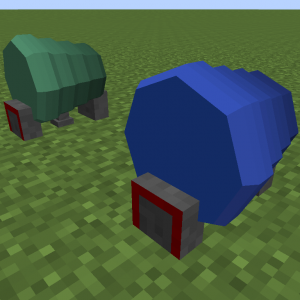Difference between revisions of "Heat Turbine"
(Merge 200V and 50V turbines into one page) |
Omega Haxors (talk | contribs) (Added efficiency values) |
||
| Line 19: | Line 19: | ||
Every machine and turbine/engine have only one terminal. The other one is hidden and connected to ground. | Every machine and turbine/engine have only one terminal. The other one is hidden and connected to ground. | ||
| + | |||
| + | == Efficiency == | ||
| + | |||
| + | When converting from heat energy into electrical energy, up to 28.16% of the energy can be converted while the rest is unavoidably lost. This means that an non-upgraded heat furnace can produce 1000W of heat and therefore generate up to 281.6W of electrical power. | ||
| + | |||
| + | * A heat furnace with no upgrades produces 281.6W | ||
| + | * A heat furnace with one upgrade produces 422.4W | ||
| + | * A heat furnace with both upgrades produces 563.2W | ||
| + | * A liquid heat furnace with a small engine produces 1,408W | ||
| + | * A liquid heat furnace with a medium engine produces 2,816W | ||
| + | * A liquid heat furnace with a large engine produces 7,040W | ||
| + | |||
| + | Remember to consider that higher heat values will require more turbines to extract from, and that more cooling will also be required. It is highly recommended to consider the active heat dissipators to maintain favorable efficiencies. | ||
Revision as of 15:31, 1 June 2017
| Block type: | Single |
| Powered by: | None |
| Requirements for operation: | Stone Heat Furnace and any kind of Thermal Dissipator |
| Stackable: | Yes (64) |
The heat turbine transfers heat energy from a high temperature on the red side into a low temperature on the blue side. This process generates electricity which can be drawn out from the both sides.
Producing Energy
Energy production can be accomplished by putting a Stone Heat Furnace on the red side, and a Small Passive Thermal Dissipator, Small Active Thermal Dissipator or an 200V Active Thermal Dissipator on the blue side.
The greater the difference in the temperature means that the more energy is produced, as proven by the pitch of the satisfying noise the engine creates.
Be careful not to spin it up too fast though, or else the machine will violently fail!
Usage
All one has to do to draw power from it is hook a machine to it.
Every machine and turbine/engine have only one terminal. The other one is hidden and connected to ground.
Efficiency
When converting from heat energy into electrical energy, up to 28.16% of the energy can be converted while the rest is unavoidably lost. This means that an non-upgraded heat furnace can produce 1000W of heat and therefore generate up to 281.6W of electrical power.
- A heat furnace with no upgrades produces 281.6W
- A heat furnace with one upgrade produces 422.4W
- A heat furnace with both upgrades produces 563.2W
- A liquid heat furnace with a small engine produces 1,408W
- A liquid heat furnace with a medium engine produces 2,816W
- A liquid heat furnace with a large engine produces 7,040W
Remember to consider that higher heat values will require more turbines to extract from, and that more cooling will also be required. It is highly recommended to consider the active heat dissipators to maintain favorable efficiencies.
